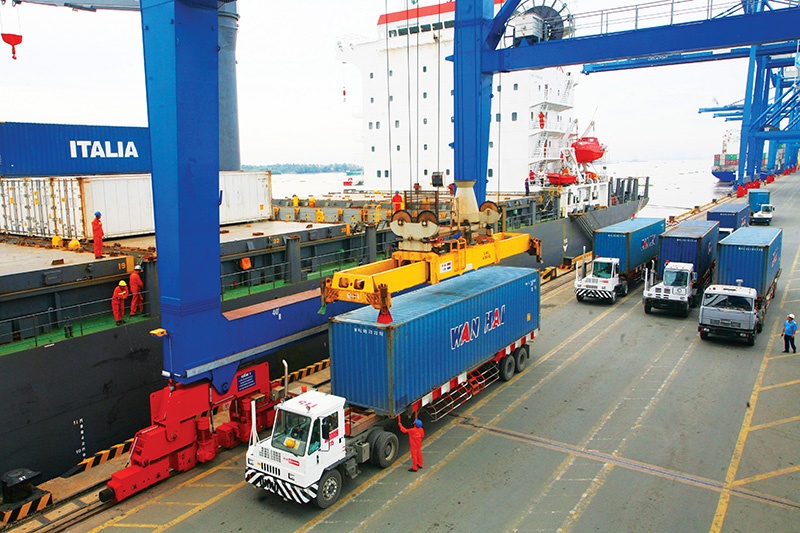Waves of variance in seaport growth
 |
| Some of the typically more profitable seaports in Vietnam have found the going tough over the past year. Photo: Le Toan |
At last week’s meeting to review the nine-month performance of the sector, shipping giant Vietnam Maritime Corporation (VIMC) highlighted the two-digit growth of its ports across the country.
Total volume of goods and commodities via seaports in Vietnam hit over 535.7 million tonnes between January and the end of September, up 3 per cent on-year. Of that, container throughput enjoyed double-digit growth of 15 per cent to nearly 18.6 million TEU, with over six million TEU exported (up 13 per cent) and over 6.1 million imported, up 18 per cent.
Seaports have been performing well despite social distancing, including those of VIMC, which enabled the group to enjoy an on-year rise of 16.8 per cent in volume and a 30.5 per cent increase in revenues during the period.
VIMC now has 35 member companies, managing over 13,000 metres of piers and accounting for nearly 30 per cent of the country’s total. These piers are capable of handling over 100 million tonnes of cargo, making up over 20 per cent of the country’s total.
For instance, the SSIT and SP-PSA ports experienced a strong growth in the volume of commodities during the nine-month span. Both are located in the Cai Mep-Thi Vai area of the southern province of Ba Ria-Vung Tau.
SSIT port, a joint venture between VIMC and SSA Marine, accommodated over 10 million tonnes of goods, equal to over 545 per cent compared to the same period last year, while its container throughput rose 44.1 per cent. Likewise, SP-PSA, a joint venture between VIMC and Singapore-based PSA, witnessed an on-year increase of over 22 per cent in volume and 17.42 per cent in revenues.
A representative of VIMC told VIR, “It is an impressive result amid social distancing. No seaports of ours stopped operations in this situation.”
However, not all seaports performed well, including some of the commonly most-profitable ones like Cai Mep International Terminal (CMIT) and other joint venture seaports like Cai Lan International Container Terminal (CICT).
According to VIMC statistics, CMIT has Denmark’s APM Terminals as a foreign stakeholder and saw its volume rise by 16.3 per cent on-month in September. The port handled over 18 million tonnes of goods in the nine-month period, including 1.2 million TEU in container throughput, equal to more than 96 per cent compared to the same period last year.
Nguyen Xuan Ky, general director of CMIT, told VIR, “Since late July, the stay-at-work policies have been affecting not only seaports but also companies that manufacture key items for export because their operations require a lot of workers. The reduced production capacity of factories in Ho Chi Minh City, Dong Nai, and Binh Duong – the southern economic hubs – resulted in a fall in commodities and goods for export via seaports.”
CICT, located in the northeastern province of Quang Ninh, accommodated more than 3.18 million tonnes of commodities and 12,000 TEU of container throughput, down 12.7 per cent, and nearly 69 per cent on-year, respectively.
September was not a rosy month for many others. Big seaports at Haiphong, Danang, and Quy Nhon saw a fall in profits during the month, together with Transvina, VIMC Dinh Vu, and VIMC Hau Giang.
Seaports in which VIMC holds a controlling stake have started to see an on-month reduction in goods and commodities since June, with on-month decreases ranging from 3 to 7.9 per cent.
According to VIMC, there remain some challenges ahead. “We see recovery in October compared to previous months, but the progress is still slow,” Ky noted.
The Organisation for Economic Co-operation and Development anticipates global economic growth of 5.7 per cent in 2021, down 0.1 per cent from initial forecasts; and 4.5 per cent in 2022. But recovery remains uneven, with countries emerging from the crisis at varying paces.
What the stars mean:
★ Poor ★ ★ Promising ★★★ Good ★★★★ Very good ★★★★★ Exceptional
Related Contents
Latest News
More News
- $250 million deal targets women-owned SMEs, sustainable agriculture (December 22, 2025 | 17:40)
- UOB sees Vietnam growth easing in fourth quarter (December 22, 2025 | 17:39)
- Government moves to establish International Financial Centre (December 21, 2025 | 21:00)
- Vietnam's IFC to target global investment flows (December 21, 2025 | 18:00)
- Ha Tinh breaks ground on major Vingroup industrial and energy projects (December 19, 2025 | 18:24)
- EVN launches major power infrastructure projects nationwide (December 19, 2025 | 18:17)
- VAL inaugurates second production line to meet domestic animal feed demand (December 19, 2025 | 16:37)
- Sun Group pioneers urban tram system in Phu Quoc (December 19, 2025 | 15:00)
- Top 10 notable events of Vietnam’s industry and trade sector in 2025 (December 19, 2025 | 14:00)
- Seven major projects launched to drive Hanoi’s next growth phase (December 19, 2025 | 14:00)

 Tag:
Tag:




















 Mobile Version
Mobile Version